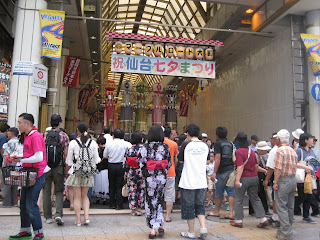The festival originated from The Festival to Plead for Skills (乞巧奠; きっこうでん Kikkouden), an alternative name for Qi Xi, which was celebrated in China and also was adopted in the Kyoto Imperial Palace from the Heian Period. The festival spread to the general public by the early Edo period, became mixed with various Obon or Bon (盆)traditions (because Bon was held on 15th of the seventh month then), and developed into the modern Tanabata festival. In the Edo period, girls wished for better sewing and craftsmanship, and boys wished for better handwriting by writing wishes on strips of paper. At this time, the custom was to use dew left on taro leaves to create the ink used to write wishes. Incidentally, Bon is now held on 15 August on the solar calendar, close to its original date on the lunar calendar, making Tanabata and Bon as further separate events.
The name Tanabata is remotely related to the Japanese reading of the Chinese letters 七夕, which used to be read as "Shichiseki" (しちせき). It is believed that a Shinto purification ceremony existed around the same time, in which a Shinto miko wove a special cloth on a loom called a Tanabata 棚機 (たなばた) near waters and offered it to a god to pray for protection of rice crops from rain or storm and for good harvest later in autumn. Gradually this ceremony merged with 乞巧奠(きっこうでん, (The Festival to Plead for Skills) and became Tanabata 七夕. Oddly the Chinese writing 七夕 and the Japanese reading Tanabata (たなばた) joined to mean the same festival, although originally they were two different things, an example of ateji.
Sendai Tanabata Festival
The Sendai Tanabata festival began shortly after the city was founded in the early Edo Period. The Tanabata festival gradually developed and became larger over the years. Although the festival's popularity started to dwindle after the Meiji Restoration, and almost disappeared during the economic depression that occurred after World War I, volunteers in Sendai revived the festival in 1928 and established the tradition of holding the festival from August 6 to August 8.
During World War II it was impossible to hold the festival, and almost no decorations were seen in the city from 1943 to 1945, but after the war, the first major Tanabata festival in Sendai was held in 1946, and featured 52 decorations. In 1947, the Showa Emperor Hirohito visited Sendai and was greeted by 5,000 Tanabata decorations. The festival subsequently developed into one of the three major summer festivals in the Tohoku region and became a major tourist attraction. The festival now includes a fireworks show that is held on August 5.
Ada tujuh jenis decoration n tiap2 satu tu represents different meanings.













